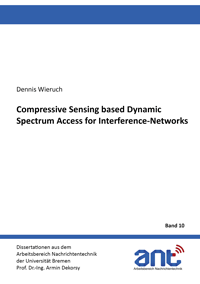
Shop : Details
Shop
Details
49,80 €ISBN 978-3-8440-8208-1Softcover246 pages43 figures366 g21 x 14,8 cmEnglishThesis
September 2021
Dennis Wieruch
Compressive Sensing based Dynamic Spectrum Access for Interference-Networks
Future wireless information and communications technologies shall address manifold scenarios and applications. Key drivers behind this diversification are especially the vertical industries such as automotive, manufacturing, and energy. In the course of the fifth generation of cellular mobile communications (5G) the manifold scenarios and applications shall be represented by a single communication infrastructure. Therefore, we need more flexibility in resource allocation and reduce signaling overhead especially in device-to-device applications.
This thesis introduces dynamic spectrum access schemes, which are enabled by compressed sensing. In particular, we propose a gray space detection scheme for cognitive radio system, which detects temporary small fraction of unused resources within an already occupied primary user spectrum band. There, gray space detection performs a uniformly most powerful one-sided composite hypothesis test exploiting noise and channel statistics. Furthermore, we extend the gray space detection scheme for multiple active transmitters simultaneously transmitting on exclusive resources. There, we propose an objective function to solve the combinatorial problem of allocation map retrieval for frequency-division multiple access signals and show that based on the objective function a receiver is able to identify the non-adjacent resources belonging to the same transmitter. Furthermore, we propose a breadth-first search approach for decision trees, which solves the allocation map retrieval problem efficient but sub optimal. Moreover, a measurement campaign is described in which practical channel models were obtained for the evaluation of dynamic spectrum access methods.
This thesis introduces dynamic spectrum access schemes, which are enabled by compressed sensing. In particular, we propose a gray space detection scheme for cognitive radio system, which detects temporary small fraction of unused resources within an already occupied primary user spectrum band. There, gray space detection performs a uniformly most powerful one-sided composite hypothesis test exploiting noise and channel statistics. Furthermore, we extend the gray space detection scheme for multiple active transmitters simultaneously transmitting on exclusive resources. There, we propose an objective function to solve the combinatorial problem of allocation map retrieval for frequency-division multiple access signals and show that based on the objective function a receiver is able to identify the non-adjacent resources belonging to the same transmitter. Furthermore, we propose a breadth-first search approach for decision trees, which solves the allocation map retrieval problem efficient but sub optimal. Moreover, a measurement campaign is described in which practical channel models were obtained for the evaluation of dynamic spectrum access methods.
Keywords: Compressed Sensing; OFDM; Multiuser
Dissertationen aus dem Arbeitsbereich Nachrichtentechnik der Universität Bremen
Edited by Prof. Dr.-Ing. Armin Dekorsy, Bremen
Volume 10
Available online documents for this title
You need Adobe Reader, to view these files. Here you will find a little help and information for downloading the PDF files.
Please note that the online documents cannot be printed or edited.
Please also see further information at: Help and Information.
Please also see further information at: Help and Information.
| Document |  | Document | ||
| Type |  | |||
| Costs |  | 37,35 € | ||
| Action |  | Purchase in obligation and download the file | ||
| Document |  | Table of contents | ||
| Type |  | |||
| Costs |  | free | ||
| Action |  | Download the file | ||
User settings for registered online customers (online documents)
You can change your address details here and access documents you have already ordered.
User
Not logged in
Export of bibliographic data
Shaker Verlag GmbH
Am Langen Graben 15a
52353 Düren
Germany
Am Langen Graben 15a
52353 Düren
Germany
Mon. - Thurs. 8:00 a.m. to 4:00 p.m.
Fri. 8:00 a.m. to 3:00 p.m.
Fri. 8:00 a.m. to 3:00 p.m.
Contact us. We will be happy to help you.



